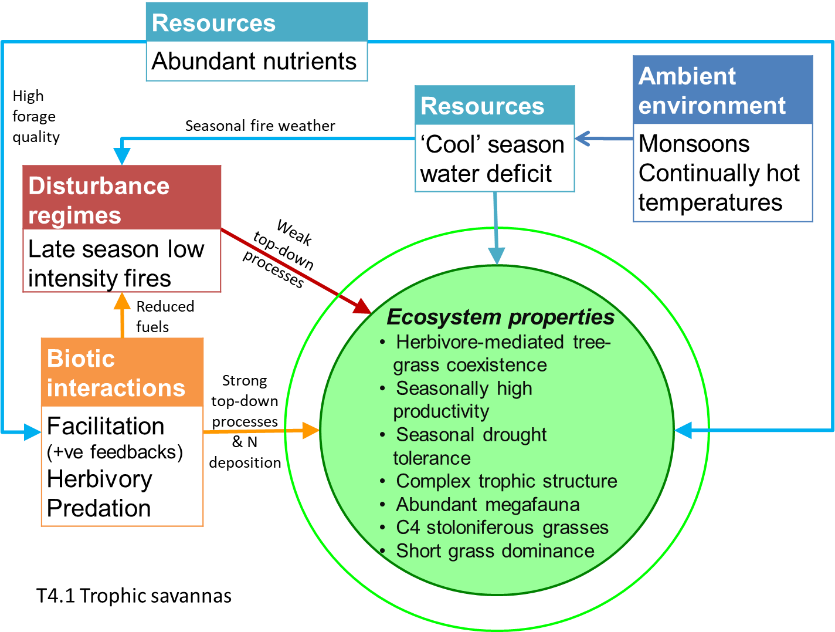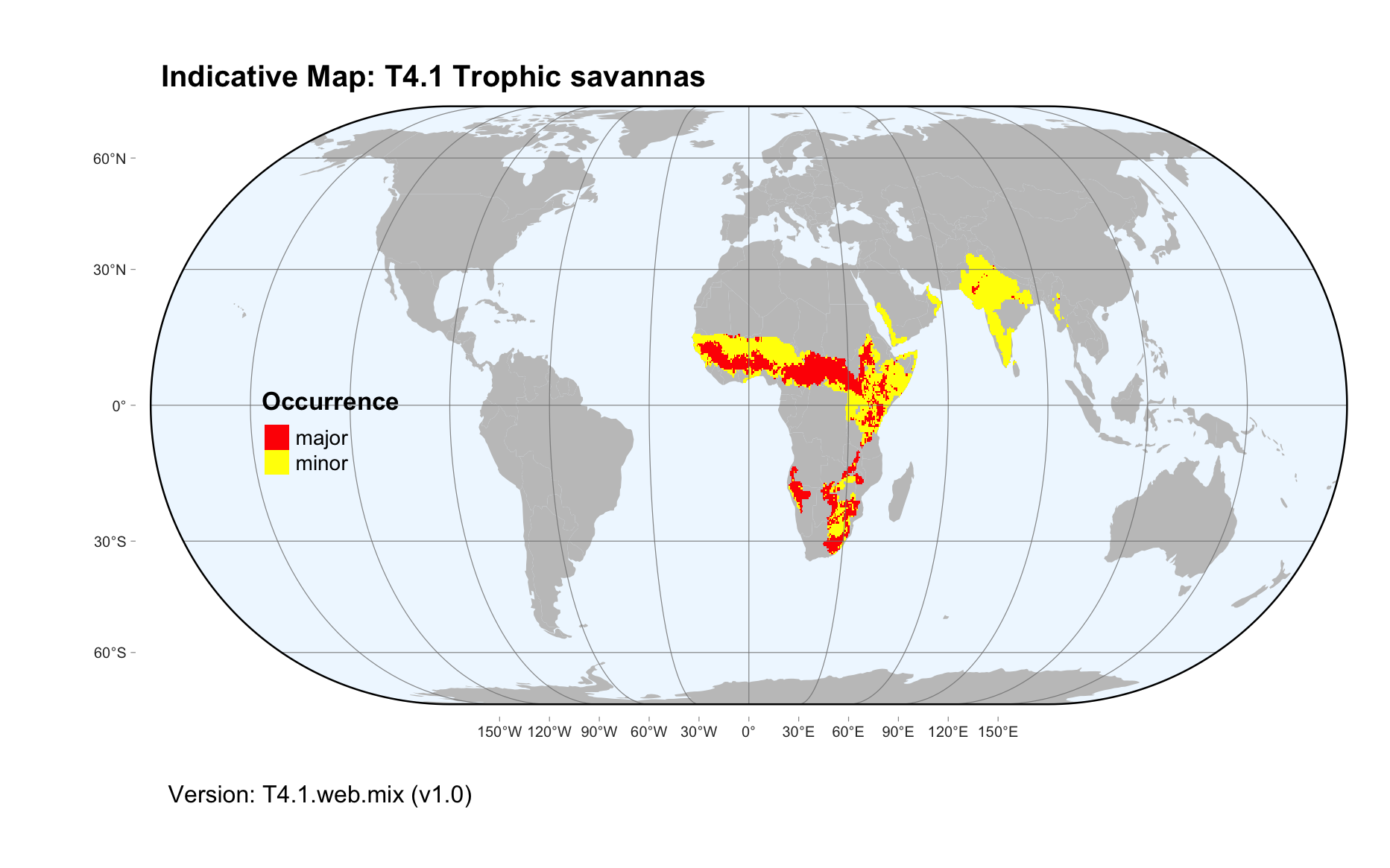Global ecosystem typology
Alternative site for the Global ecosystem typology with additional information for ecosystem profiles and indicative maps.
This site is maintained by jrfep
T4.1 Trophic savannas
Biome: T4. Savannas and grasslands biome
Contributors:
(texts)
An unparalleled abundance and diversity of large herbivores maintain an open structure of these tree-grass ecosystems in the seasonal tropics of Africa and south Asia. Large herbivores are pivotal in maintaining short rhizomatous and tussock grasses, limiting recruitment of trees, cycling nutrients, sustaining complex food webs of invertebrate detritivores and diverse assemblages of mammalian and avian predators and scavengers. Seasonally high productivity coincides with the summer rainy season. Fires occur in some years, but are less influential than herbivores on ecosystem function. Trees and grasses have adaptations to seasonal drought and heavy browsing, such as rhizomes and stolons that allow grasses to spread under grazing pressure.
Key Features
Grassy woodlands and grasslands dominated by C4 grasses in seasonal climates with lower rainfall and higher soil fertility..
Overview of distribution
African and Asian wet/dry tropics & subtropics.
Profile versions
- v1.0 (2020-01-20): CER Lehmann; DA Keith
- v2.0 (2020-05-31): CER Lehmann; DA Keith
- v2.01 ():
- v2.1 (2022-04-06): CER Lehmann; DA Keith Full profile available at official site
Main references
Selected references for this functional group:
Hempson GP, Archibald S, Bond WJ, Ellis RP, Grant CC, Kruger FJ, et al. (2015) Ecology of grazing lawns in Africa Biological Reviews 90: 979–994
Archibald S, Hempson GP (2016) Competing consumers: contrasting the patterns and impacts of fire and mammalian herbivory in Africa Phil Trans R Soc B 371: 20150309
Diagrammatic assembly model

Maps
Maps are indicative of global distribution patterns are not intended to represent fine-scale patterns. The maps show areas of the world containing major (coloured red) or minor occurrences (coloured yellow) of each ecosystem functional group. See general notes on maps.
There are 2 alternative versions of the indicative map for this functional group, please compare description and sources below.
T4.1.IM.mix_v1.0
Datasets
- EarthEnv-LandCover-v1.0
- Resolve-Ecoregions-2017
Map references
Tuanmu, M.-N. and W. Jetz (2014) A global 1-km consensus land-cover product for biodiversity and ecosystem modeling Global Ecology and Biogeography 23(9):1031–1045 DOI:10.1111/geb.12182
Dinerstein E, Olson D, Joshi A, Vynne C, Burgess ND, Wikramanayake E, Hahn N, Palminteri S, Hedao P, Noss R, Hansen M, Locke H, Ellis EE, Jones B, Barber CV, Hayes R, Kormos C, Martin V, Crist E, Sechrest W, Price L, Baillie JEM, Weeden D, Suckling K, Davis C, Sizer N, Moore R, Thau D, Birch T, Potapov P, Turubanova S, Tyukavina A, de Souza N, Pintea L, Brito JC, Llewellyn Barnekow Lillesø JP, van Breugel P, Graudal L, Voge M, Al-Shammari KF, Saleem M (2017) An Ecoregion-Based Approach to Protecting Half the Terrestrial Realm, BioScience 67: 534–545. DOI:10.1093/biosci/bix014. Data-set available on-line
T4.1.web.mix_v1.0

Datasets
- EarthEnv-LandCover-v1.0
- Resolve-Ecoregions-2017
Map references
Tuanmu, M.-N. and W. Jetz (2014) A global 1-km consensus land-cover product for biodiversity and ecosystem modeling Global Ecology and Biogeography 23(9):1031–1045 DOI:10.1111/geb.12182
Dinerstein E, Olson D, Joshi A, Vynne C, Burgess ND, Wikramanayake E, Hahn N, Palminteri S, Hedao P, Noss R, Hansen M, Locke H, Ellis EE, Jones B, Barber CV, Hayes R, Kormos C, Martin V, Crist E, Sechrest W, Price L, Baillie JEM, Weeden D, Suckling K, Davis C, Sizer N, Moore R, Thau D, Birch T, Potapov P, Turubanova S, Tyukavina A, de Souza N, Pintea L, Brito JC, Llewellyn Barnekow Lillesø JP, van Breugel P, Graudal L, Voge M, Al-Shammari KF, Saleem M (2017) An Ecoregion-Based Approach to Protecting Half the Terrestrial Realm, BioScience 67: 534–545. DOI:10.1093/biosci/bix014. Data-set available on-line
Check: the Glossary / Profile structure / the public document